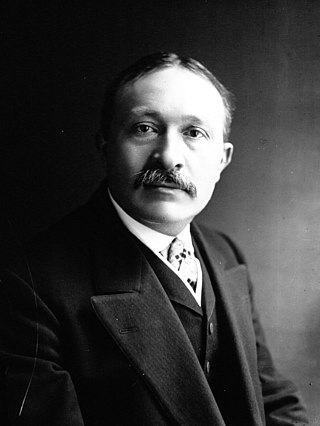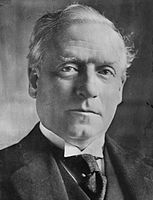
David Lloyd George, 1st Earl Lloyd-George of Dwyfor, was Prime Minister of the United Kingdom from 1916 to 1922. A Liberal Party statesman and politician from Wales, he was known for leading the United Kingdom during the First World War, for social-reform policies, for his role in the Paris Peace Conference, and for negotiating the establishment of the Irish Free State. He was the last Liberal Party prime minister; the party fell into third-party status shortly after the end of his premiership.

Field Marshal Horatio Herbert Kitchener, 1st Earl Kitchener, was a senior British Army officer and colonial administrator. Kitchener came to prominence for his imperial campaigns, his involvement in the Second Boer War, and his central role in the early part of the First World War.

Field Marshal Douglas Haig, 1st Earl Haig, was a senior officer of the British Army. During the First World War he commanded the British Expeditionary Force (BEF) on the Western Front from late 1915 until the end of the war. He was commander during the Battle of the Somme, the Battle of Arras, the Third Battle of Ypres, the German Spring Offensive, and the Hundred Days Offensive.

Joseph Jacques Césaire Joffre was a French general who served as Commander-in-Chief of French forces on the Western Front from the start of World War I until the end of 1916. He is best known for regrouping the retreating allied armies to defeat the Germans at the strategically decisive First Battle of the Marne in September 1914.

Aristide Pierre Henri Briand was a French statesman who served eleven terms as Prime Minister of France during the French Third Republic. He is mainly remembered for his focus on international issues and reconciliation politics during the interwar period (1918–1939).

Field Marshal John Denton Pinkstone French, 1st Earl of Ypres,, known as Sir John French from 1901 to 1916, and as The Viscount French between 1916 and 1922, was a senior British Army officer. Born in Kent to an Anglo-Irish family, he saw brief service as a midshipman in the Royal Navy, before becoming a cavalry officer. He achieved rapid promotion and distinguished himself on the Gordon Relief Expedition. French had a considerable reputation as a womaniser throughout his life, and his career nearly ended when he was cited in the divorce of a brother officer while in India in the early 1890s.

Field Marshal Sir Henry Hughes Wilson, 1st Baronet, was one of the most senior British Army staff officers of the First World War and was briefly an Irish unionist politician.

Ferdinand Foch was a French general and military theorist who served as the Supreme Allied Commander during the First World War. An aggressive, even reckless commander at the First Marne, Flanders and Artois campaigns of 1914–1916, Foch became the Allied Commander-in-Chief in late March 1918 in the face of the all-out German spring offensive, which pushed the Allies back using fresh soldiers and new tactics that trenches could not withstand. He successfully coordinated the French, British and American efforts into a coherent whole, deftly handling his strategic reserves. He stopped the German offensive and launched a war-winning counterattack. In November 1918, Marshal Foch accepted the German cessation of hostilities and was present at the Armistice of 11 November 1918.

Jean Raphaël Adrien René Viviani was a French politician of the Third Republic, who served as Prime Minister for the first year of World War I. He was born in Sidi Bel Abbès, in French Algeria. In France he sought to protect the rights of socialists and trade union workers.

The Battle of Loos took place from 25 September to 8 October 1915 in France on the Western Front, during the First World War. It was the biggest British attack of 1915, the first time that the British used poison gas and the first mass engagement of New Army units. The French and British tried to break through the German defences in Artois and Champagne and restore a war of movement. Despite improved methods, more ammunition and better equipment, the Franco-British attacks were largely contained by the Germans, except for local losses of ground. The British gas attack failed to neutralize the defenders and the artillery bombardment was too short to destroy the barbed wire or machine gun nests. German tactical defensive proficiency was still dramatically superior to the British offensive planning and doctrine, resulting in a British defeat.

The First Battle of Ypres was a battle of the First World War, fought on the Western Front around Ypres, in West Flanders, Belgium. The battle was part of the First Battle of Flanders, in which German, French, Belgian armies and the British Expeditionary Force (BEF) fought from Arras in France to Nieuwpoort (Nieuport) on the Belgian coast, from 10 October to mid-November. The battles at Ypres began at the end of the Race to the Sea, reciprocal attempts by the German and Franco-British armies to advance past the northern flank of their opponents. North of Ypres, the fighting continued in the Battle of the Yser (16–31 October), between the German 4th Army, the Belgian army and French marines.

Field Marshal Sir William Robert Robertson, 1st Baronet, was a British Army officer who served as Chief of the Imperial General Staff (CIGS) – the professional head of the British Army – from 1916 to 1918 during the First World War. As CIGS he was committed to a Western Front strategy focusing on Germany and was against what he saw as peripheral operations on other fronts. While CIGS, Robertson had increasingly poor relations with David Lloyd George, Secretary of State for War and then Prime Minister, and threatened resignation at Lloyd George's attempt to subordinate the British forces to the French Commander-in-Chief, Robert Nivelle. In 1917 Robertson supported the continuation of the Battle of Passchendaele at odds with Lloyd George's view that Britain's war effort ought to be focused on the other theatres until the arrival of sufficient US troops on the Western Front.

Joseph Simon Gallieni was a French soldier, active for most of his career as a military commander and administrator in the French colonies. Gallieni is infamous in Madagascar as the French military leader who exiled Queen Ranavalona III and abolished the 350-year-old monarchy on the island.

The Third Battle of Artois, was fought by the French Tenth Army against the German 6th Army on the Western Front of the First World War. The battle included the Battle of Loos by the British First Army. The offensive, meant to complement the Second Battle of Champagne, was the last attempt that year by Joseph Joffre, the French commander-in-chief, to exploit an Allied numerical advantage over Germany. Simultaneous attacks were planned in Champagne-Ardenne to capture the railway at Attigny and in Artois to take the railway line through Douai, to force a German withdrawal from the Noyon salient.
The Supreme War Council was a central command based in Versailles that coordinated the military strategy of the principal Allies of World War I: Britain, France, Italy, the US and Japan. It was founded in 1917 after the Russian revolution and with Russia's withdrawal as an ally imminent. The council served as a second source of advice for civilian leadership, a forum for preliminary discussions of potential armistice terms, later for peace treaty settlement conditions, and it was succeeded by the Conference of Ambassadors in 1920.

Maurice Paul Emmanuel Sarrail was a French general of the First World War. Sarrail's openly socialist political connections made him a rarity amongst the Catholics, conservatives and monarchists who dominated the French Army officer corps under the Third Republic before the war, and were the main reason why he was appointed to command at Salonika.

Henri Mathias Berthelot was a French general during World War I. He held an important staff position under Joseph Joffre, the French commander-in-chief, at the First Battle of the Marne, before later commanding a corps in the front line. In 1917 he helped to rebuild the Romanian Army following its disastrous defeat the previous autumn, then in summer 1918 he commanded French Fifth Army at the Second Battle of the Marne, with some British and Italian troops under his command. In the final days of the war he again returned to Romania, helping fight the Hungarians during the Hungarian–Romanian War and then briefly commanded French intervention forces in southern Russia in the Russian Civil War, fighting the Russian Bolsheviks in Bessarabia (1918).

The Chantilly Conferences were a series of three conferences held between 1915 and 1916 by the Allied Powers of World War I. The conferences were named after Chantilly, France, where the meetings took place.

The Calais Conference was a 26 February 1917 meeting of politicians and generals from France and the United Kingdom. Ostensibly about railway logistics for the upcoming allied Spring offensive the majority of the conference was given over to a plan to bring British forces under overall French command. The British Prime Minister David Lloyd George was supportive of the proposal and arranged for the British war cabinet to approve it in advance of the conference, without the knowledge of senior British generals Douglas Haig and Sir William Robertson. The latter were surprised when the proposal was presented by French General Robert Nivelle at the conference. The next day the two generals met with Lloyd George and threatened their resignations rather than implement the proposal. This led to the significant watering-down of the plan with greater freedom given to British commanders. The conference caused mistrust between the British civil and military chiefs and set back the cause of a unified allied command until Spring 1918, when the successful German spring offensive rendered it essential.
The Calais Conference took place in the French city on 4 December 1915. It was the second Anglo-French political conference in Calais that year, following a conference on war strategy in July. The December conference focussed mainly on the issue of whether to continue the war on the Salonika Front. The British, under prime minister H. H. Asquith, foreign secretary Edward Grey and secretary of state for war Lord Kitchener favoured evacuation of the front following the loss of Serbia to Bulgarian occupation, the French under prime minister Aristide Briand, favoured continuing the effort.





















